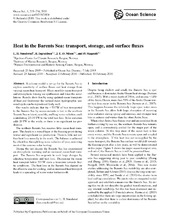Heat in the Barents Sea: Transport, storage, and surface fluxes
Journal article
Permanent lenke
https://hdl.handle.net/1956/3791Utgivelsesdato
2010-01-11Metadata
Vis full innførselSamlinger
Sammendrag
A column model is set up for the Barents Sea to explore sensitivity of surface fluxes and heat storage from varying ocean heat transport. Mean monthly ocean transport and atmospheric forcing are synthesised and force the simulations. Results show that by using updated ocean transports of heat and freshwater the vertical mean hydrographic seasonal cycle can be reproduced fairly well. Our results indicate that the ~70 TW of heat transported to the Barents Sea by ocean currents is lost in the southern Barents Sea as latent, sensible, and long wave radiation, each contributing 23–39 TW to the total heat loss. Solar radiation adds 26 TW in the south, as there is no significant ice production. The northern Barents Sea receives little ocean heat transport. This leads to a mixed layer at the freezing point during winter and significant ice production. There is little net surface heat loss annually in the north. The balance is achieved by a heat loss through long wave radiation all year, removing most of the summer solar heating. During the last decade the Barents Sea has experienced an atmospheric warming and an increased ocean heat transport. The Barents Sea responds to such large changes by adjusting temperature and heat loss. Decreasing the ocean heat transport below 50 TW starts a transition towards Arctic conditions. The heat loss in the Barents Sea depend on the effective area for cooling, and an increased heat transport leads to a spreading of warm water further north.
